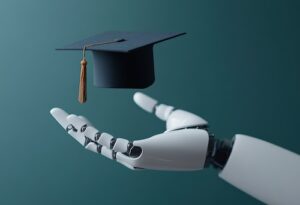Key points:
- Education must remain centered on curiosity, connection, and human agency
- 4 ways AI is empowering the next generation of great teachers
- The rise of AI-native universities: OpenAI’s vision for every student
- For more news on AI, visit eCN’s AI in Education hub
It is 6:45 a.m. in the year 2045, and Maya wakes to the gentle chime of her AI-integrated learning assistant. The device, embedded into her home’s wall system, has already analyzed her biometric data, sleep cycle, and class schedule to recommend a custom morning routine. Today’s recommendation is a brief guided meditation, followed by a protein-based breakfast delivered via drone from the university’s dining cooperative. Before her feet touch the floor, her education has already begun.
This imagined morning may sound futuristic, but it echoes observations made by economist Tyler Cowen, who argues that traditional forms of homework and testing are “obsolete” in today’s generative-AI era and urges institutions to shift toward mentorship-based learning focused on critical thinking and adaptability. Similarly, his earlier call to allocate up to one-third of college curricula to teaching students how to work with AI underscores the rapidly evolving educational landscape.
Personalized, yet isolated
By 7:30 a.m., Maya sits in her living-room pod–a VR-enabled capsule leased from the university. Her “classroom” is a fully immersive space, populated by holographic peers and an AI professor whose style is shaped by decades of optimized teaching patterns. Though the simulation feels tangible, Maya has never interacted face-to-face with another student. The dismantling of physical campuses, accelerated by political defunding and institutional consolidation, has rendered higher education dispersed across digital realms.
The AI professor greets the class: “Welcome to your future, built by your data.” Every keystroke, gaze, and even neural flicker is meticulously logged and analyzed. For students like Maya, whose tuition is partially sponsored by tech corporations, personal data is not optional–it is the currency of enrollment.
The shadow of market forces
Two hours later, Maya’s AI assistant alerts her to an update in her academic‑performance dashboard. Her scholarship, underwritten by a tech conglomerate, mandates constant engagement and predictive performance metrics. In this environment, students are transformed from learners into products within an economic engine–a trajectory anticipated in critical university studies, which examine how higher education increasingly aligns with corporate logic, treating students as commodities rather than scholars.
By 2045, universities operate much like corporations, beholden to shareholder metrics and algorithmic efficiency. Traditional ranking systems have dissolved, replaced by AI-generated value indices. Students learn to optimize employability scores, sidelining intellectual exploration.
The promise and peril of belonging
At noon, Maya attends a seminar titled “Collective Growth and Innovation,” one of the few human-centered courses remaining. Evolved from earlier DEI efforts, it now bears the label “Belonging & Opportunity” to garner wider political acceptance. Yet even this space is curated by AI, which forms breakout groups using compatibility algorithms and sentiment analysis.
While this algorithmic approach may seem efficient, scholars warn of the risk of echo chambers and inequity. Research in educational AI, including the work of Joy Buolamwini, highlights how AI systems can disproportionately harm underrepresented individuals unless bias is actively challenged through design and accountability mechanisms.
The student’s burden
By evening, Maya reflects on her day. Her assignments, auto-graded; her participation, meticulously logged; her career prospects, updated in real time. Yet what she feels is fatigue–not fulfillment. The demands of higher education in 2045 are constant: availability, optimization, surveillance. The intellectual freedom once celebrated in liberal education traditions now seems like a relic.
She recalls her grandfather’s words: “College used to be about discovering who you were.” For her, that process has been replaced by predictive analytics and calibrated pathways. There’s little room for failure, experimentation, or spontaneous conversation in campus quads or coffee shops.
A call to action
This fictional glimpse of 2045 is not predetermined–but is entirely plausible. The deep integration of AI in learning, combined with decades of disinvestment and privatization, could yield an educational system that is efficient but impersonal, personalized but isolating, technologically advanced but socially diminished. Indeed, a recent study in PubMed Central indicates that greater use of AI in education may enhance efficiency but simultaneously increase student isolation and contribute to reduced interpersonal engagement and emotional well-being.
Today’s educators, leaders, and students have a choice: Will they allow algorithms to define education’s future, or reclaim its human purpose? AI can be a catalyst for positive transformation, but only if accompanied by intentional pedagogy, critical oversight, and equity-focused design.
The future is not waiting 20 years–it is being coded now. Stakeholders must act immediately to ensure education remains centered on curiosity, connection, and human agency–not metrics, automation, and disconnection.
- The quiet collapse: What the partial U.S. government shutdown means for higher education - October 17, 2025
- Ethics besieged in higher education–and how AI can fire back - October 6, 2025
- Democracy’s future and the fate of higher education - September 19, 2025
